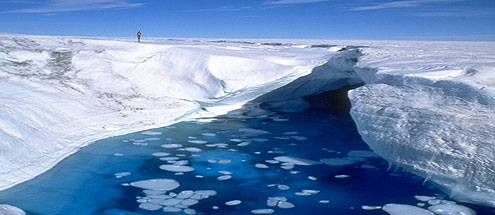
Speed of the arctic ice melt has accelerated to such an extent that dire consequences predicted by the UN International Panel on Climate Change (IPCC) seem way outdated. The movements of gigantic pieces of melting ice are creating shock waves that register up to three on the Richter scale.This might be leading to an increase in earthquakes. Glacial earthquakes in north-west Greenland did not exist until three years ago.
The impact of human-induced global warming on Earth’s ice has crossed beyond what was envisaged. Researches now feel that going by the new data, at this rate, ocean levels are likely to rise by about two meters in a hundred years.
Greenland’s ice cap is immense, the second largest in the world, and its break-up would be catastrophic. The packed ice is up to two miles thick and its total collapse into the ocean would raise worldside sea levels by seven metres.
How do the earthquakes get triggered by melting ice?
At the Ilulissat Icefjord, 250km north of the Arctic Circle, the advance of the glacier into the sea is now visible to the naked eye. As the glaciers thaw, pools of water are forming, feeding fractures in the ice, down which the water flows until it hits the bedrock. It is comparable to oil underneath the ice to make it move forward faster. The process is making it almost impossible for scientists to make any accurate prior predictions on time taken for thawing.
The accelerating thaw and and earthquakes are closely connected. The Finnish scientist Veli Albert Kallio, one of the region’s leading ice experts believes that as immense slabs of ice are sheared from the bed rock by melt water. Those blocks of ice, often more than 800m deep and 1500m long, contain immense rocks as well and move against geological faults with seismic consequences.
Though this study is still in its infancy the research predicts explosive consequences. The scientific models made five years ago to predict when ice would melt and how much have already failed. Just in five years, we are at the levels, which were predicted for 2040. Where will we be in 2050? Will we probably be submerged under water?
Image credit
Source: The independent


